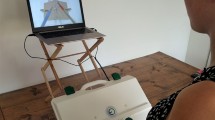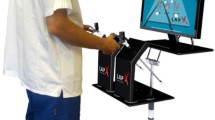Abstract
Background
Laparoscopic camera navigation (LCN) training on simulators has demonstrated transferability to actual operations, but no comparative data exist. The objective of this study was to compare the construct and face validity, as well as workload, of two previously validated virtual reality (VR) and videotrainer (VT) systems.
Methods
Attendees (n = 90) of the SAGES 2005 Learning Center performed two repetitions on both VR (EndoTower™) and VT (Tulane Trainer) LCN systems using 30° laparoscopes and completed a questionnaire regarding demographics, simulator characteristics, and task workload. Construct validity was determined by comparing the performance scores of subjects with various levels of experience according to five parameters and face validity according to eight. The validated NASA-TLX questionnaire that rates the mental, physical, and temporal demand of a task as well as the performance, effort, and frustration of the subject was used for workload measurement.
Results
Construct validity was demonstrated for both simulators according to the number of basic laparoscopic cases (p = 0.005), number of advanced cases (p < 0.001), and frequency of angled scope use (p < 0.001), and only for VT according to training level (p < 0.001) and fellowship training (p = 0.008). Face validity ratings on a 1-20 scale averaged 15.4 ± 3 for VR vs. 16 ± 2.6 for VT (p = 0.04). Ninety-six percent of participants rated both simulators as valid educational tools. The NASA-TLX overall workload score was 69.5 ± 24 for VR vs. 68.8 ± 20.5 for VT (p = 0.31).
Conclusions
This is the largest study to date that compares two validated LCN simulators. While subtle differences exist, both VR and VT simulators demonstrated excellent construct validity, good face validity, and acceptable workload parameters. These systems thus represent useful training devices and should be widely used to improve surgical performance.





Similar content being viewed by others
References
Ericsson KA (2004) Deliberate practice and the acquisition and maintenance of expert performance in medicine and related domains. Acad Med 79: S70–S81
Ganai S, Seymour NE (2005) VR to OR for Camera Navigation. In: Westwood JD, et al. (eds), Medicine Meets Virtual Reality 13, vol 111, IOC press, Amsterdam, pp 45–48
Haluck RS, Gallagher AG, Satava RM, Webster R, Bass TL, Miller CA (2002) Reliability and validity of Endotower, a virtual reality trainer for angled endoscope navigation. Stud Health Technol Inform 85: 179–184
Haluck RS, Webster RW, Snyder AJ, Melkonian MG, Mohler BJ, Dise ML, Lefever A (2001) A virtual reality surgical trainer for navigation in laparoscopic surgery. Stud Health Technol Inform 81: 171–176
Hart SG, Staveland LE (1988) Development of a multi-dimensional workload rating scale: Results of empirical and theoretical research. In: Hancock PA, Meshkati N (eds), Human Mental Workload. Elsevier, Amsterdam, pp 139–183
Korndorffer JR Jr, Stefanidis D, Sierra R, Clayton JL, et al. (2005) Validity and reliability of a videotrainer laparoscopic camera navigation simulator. Surg Endosc 19 (Suppl): S246
Korndorffer JR Jr, Hayes DJ, Dunne JB, Sierra R, Touchard CL, Markert RJ, Scott DJ (2005) Development and transferability of a cost-effective laparoscopic camera navigation simulator. Surg Endosc 19: 161–167
Maithel S, Sierra R, Korndorffer J, Neumann P, Dawson S, Callery M, Jones D, Scott D (2006) Construct and face validity of MIST-VR, Endotower, and CELTS: are we ready for skills assessment using simulators? Surg Endosc 20: 104–112
O’Donnell RD, Eggemeier FT (1986) Workload assessment methodology. In: Boff KR, Kaufman L, Thomas JP (eds), Handbook of perception and performance, vol. 2: Cognitive processes and performance. Wiley, New York, pp 42.1–42.49
Perkins N, Starkes JL, Lee TD, Hutchison C (2002) Learning to use minimal access surgical instruments and 2-dimensional remote visual feedback: how difficult is the task for novices? Adv Health Sci Educ Theory Pract 7: 117–131
Peters JH, Fried GM, Swanstrom LL, Soper NJ, Sillin LF, Schirmer B, Foffman K, SAGES FLS Committee (2004) Development and validation of a comprehensive program of education and assessment of the basic fundamentals of laparoscopic surgery. Surgery 135: 21–27
Scott DJ, Jones DB (2005) Virtual reality training and teaching tools. In: Soper NJ, Swanstrom LL, Eubanks WS (eds), Mastery of Endoscopic and Laparoscopic Surgery, 2nd ed. Lippincott Williams & Wilkins, Philadelphia, pp 146–160
Stefanidis D, Korndorffer JR, Scott DJ (2005) Robotic laparoscopic fundoplication. Curr Treat Options Gastroenterol 8: 71–83
Stefanidis D, Korndorffer JR Jr, Sierra R, Touchard C, Dunne JB, Scott DJ (2005) Skill retention following proficiency-based laparoscopic simulator training. Surgery 138: 165–170
Wickens CD, Hollands J (2000) Engineering psychology and human performance. Prentice Hall, Upper Saddle River, NJ
Acknowledgments
The authors gratefully acknowledge SAGES, Verefi Inc., and Karl Storz Endoscopy for equipment support.
Author information
Authors and Affiliations
Corresponding author
Additional information
Presented at the SAGES 2006 Annual Meeting, Dallas, TX, April 26–29
Rights and permissions
About this article
Cite this article
Stefanidis, D., Haluck, R., Pham, T. et al. Construct and face validity and task workload for laparoscopic camera navigation: virtual reality versus videotrainer systems at the SAGES Learning Center. Surg Endosc 21, 1158–1164 (2007). https://doi.org/10.1007/s00464-006-9112-9
Received:
Accepted:
Published:
Issue Date:
DOI: https://doi.org/10.1007/s00464-006-9112-9




